Google Nexus 4 Review - Google's new Flagship
by Brian Klug on November 13, 2012 8:45 AM EST- Posted in
- Smartphones
- LG
- Android
- Mobile
- APQ8064
- Nexus 4
- Android 4.2
- MDM9215
The Nexus 4 is based around a 1.5 GHz Qualcomm Snapdragon S4 Pro SoC, the quad core Krait APQ8064 with Adreno 320 GPU, which is still built on a 28nm process. The combination of APQ8064 for AP and MDM9x15 for baseband is Qualcomm's Fusion 3 platform, and the Nexus 4 and Optimus G are the first phones to market based on that platform. This is a relatively unique opportunity for Nexus, which until recently wasn't really first to market with the latest and greatest silicon.
A while ago we posted our Nexus 4 and Nexus 10 performance preview. At that point we still had a lot of testing to perform, and many people noted that the Nexus 4 performance was far behind the LG Optimus G despite it being based on the same platform. Later, some people noticed that I had uploaded another set of results from GLBenchmark 2.5 to the online result browser with much better performance. The difference wasn't some over the air software update but rather that I was running some of the tests with the Nexus 4 in a ziplock bag inside the freezer to mitigate any condensation problems, and simultaneously nail down any possible thermal throttling.
I've re-run everything and can confirm obviously that there was thermal throttling going on affecting some of the results, and have included the new results wherever there was a deviation from previous. For those wondering why the LG Optimus G wasn't affected in spite of it having the same platform, the reason is because the results from the Optimus G were run in parts due to some instability affecting its ability to run a complete set of tests without crashing. The Nexus 4 has newer drivers that don't crash during a full GLBenchmark 2.5 run but as a result run the device long enough for thermal throttling to kick in.
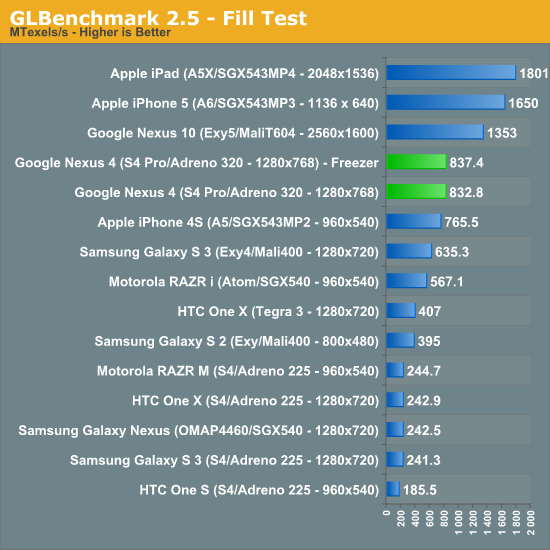
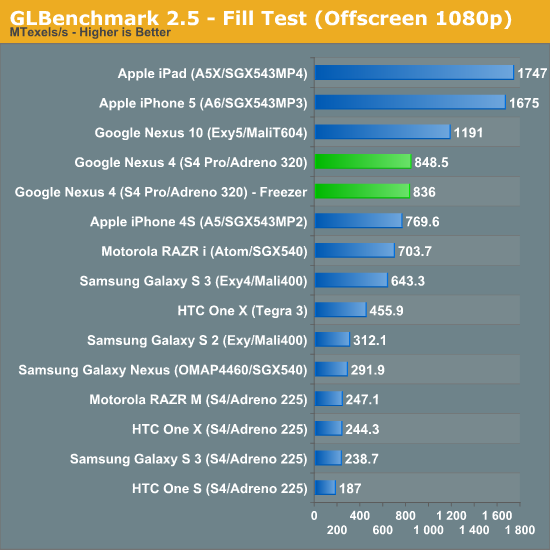
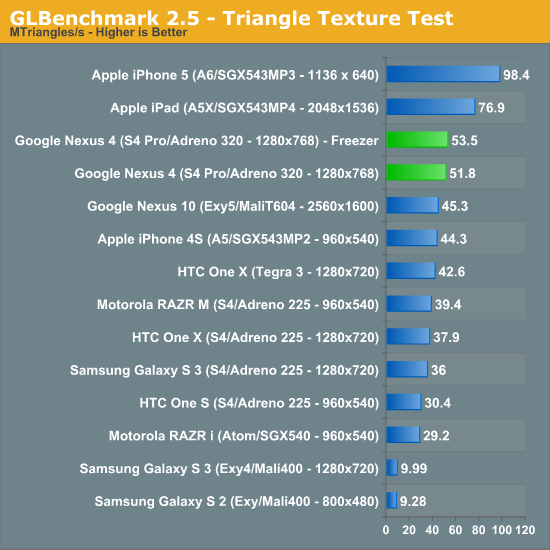
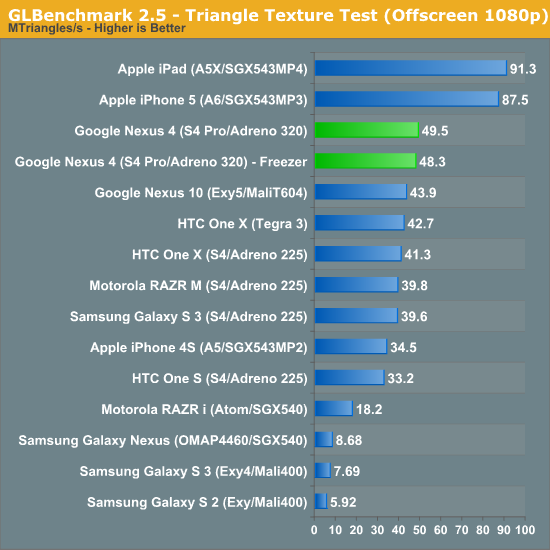
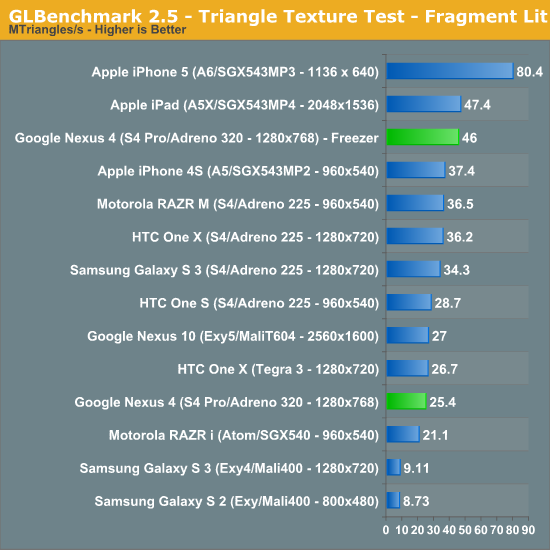
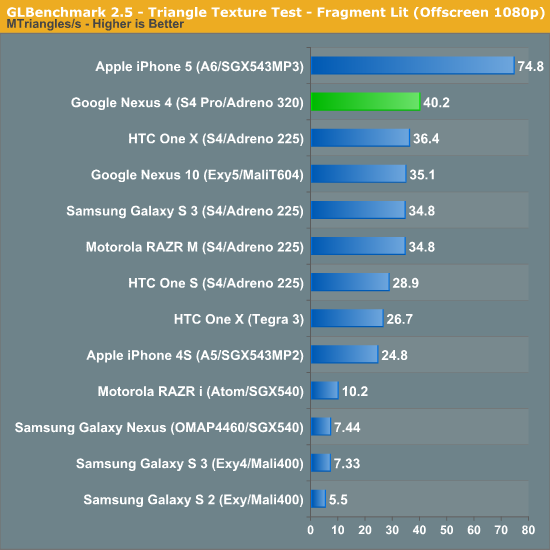
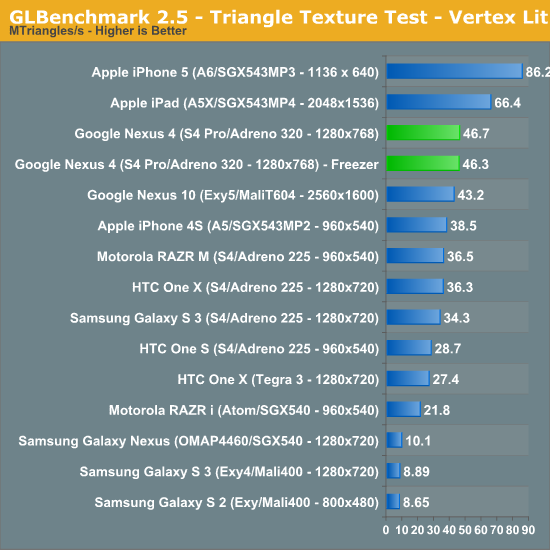
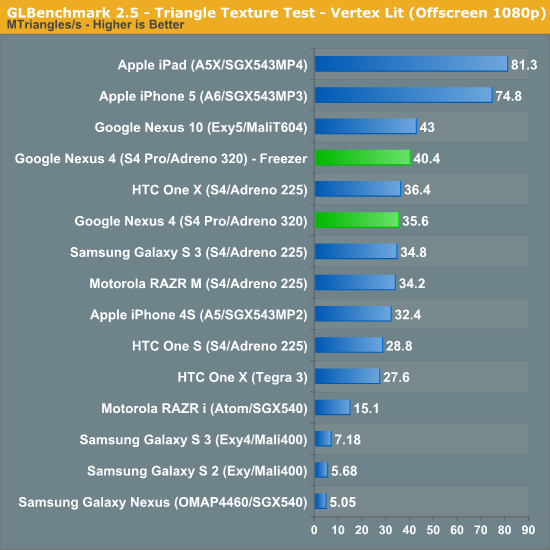
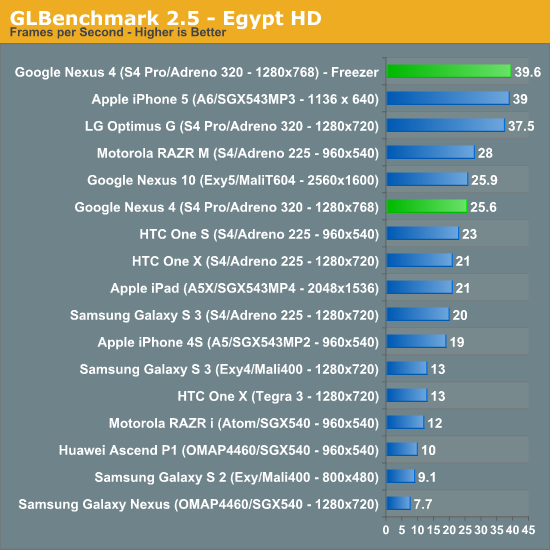
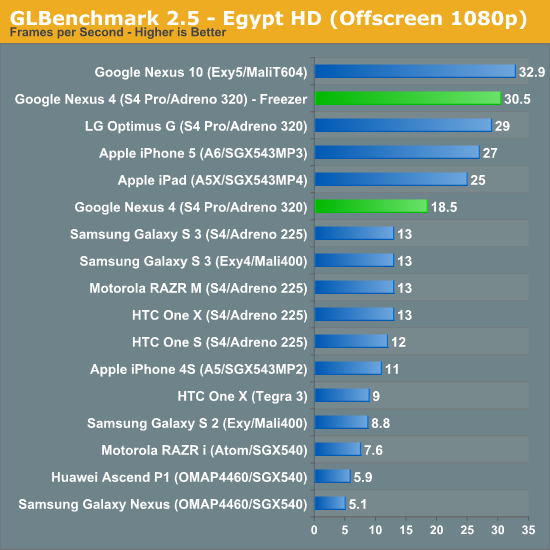
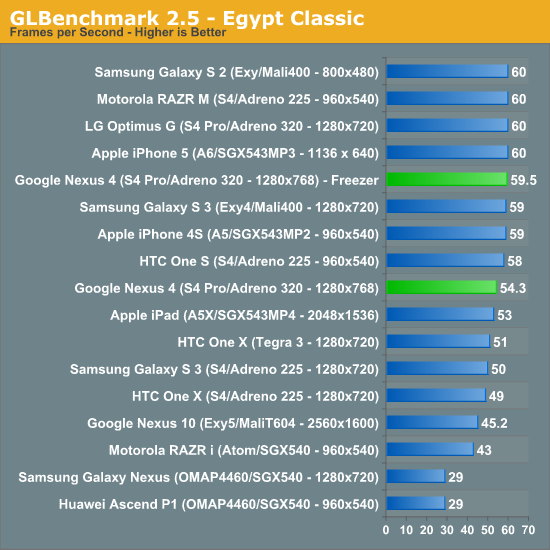
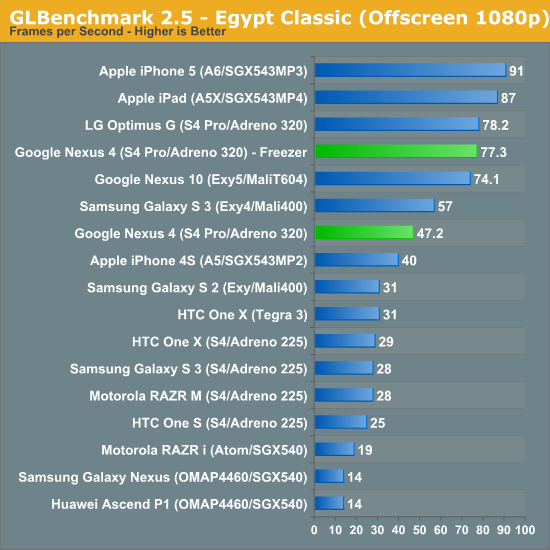
The result of the tests in the freezer results that are much closer to what we'd expect based on the APQ8064 MDP/T runs and the Optimus G numbers I saw in Korea.
When it comes to the CPU side of things there were results also affected by thermal throttling. I spaced some of those runs out (unintentionally) enough that performance didn't change, but for other things it did affect performance. I can't tell what GPU clocks end up being when the SoC decides to throttle, but it is possible to nail down what CPU performance state APQ8064 settles down into when there's throttling going on by looking at the state tables.

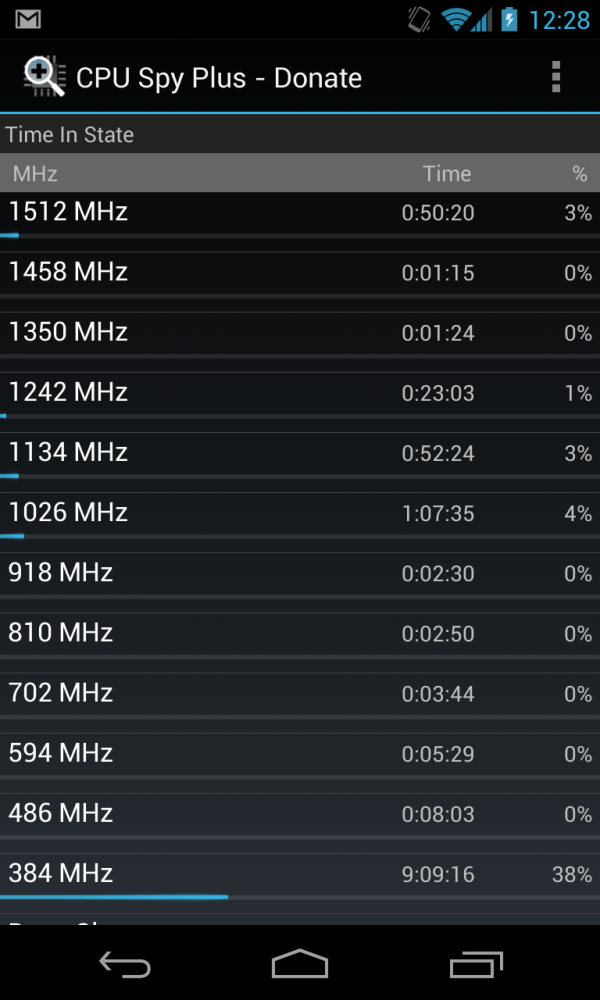
Left - 1.134 GHz during throttling (running tests), Right - All the performance states
I can see the Nexus 4 not use any of the performance states above 1134 MHz when it's getting hot, as shown in the images above. I've tweeted a link to the pastebin for thermald.conf which I believe configures the thermal cutoffs and will be interesting to kernel hackers trying to play with these values.
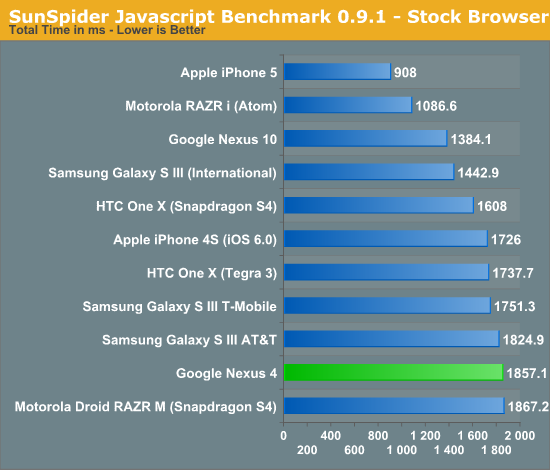
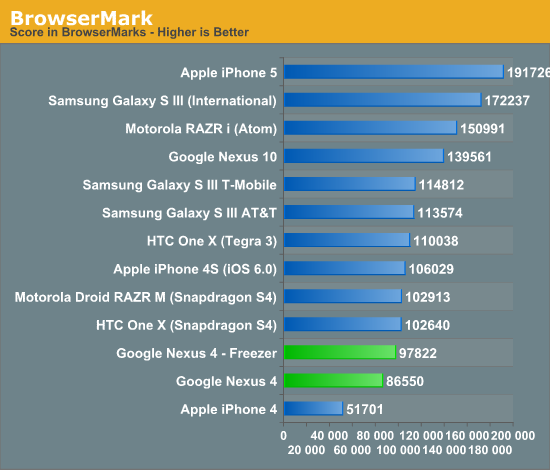
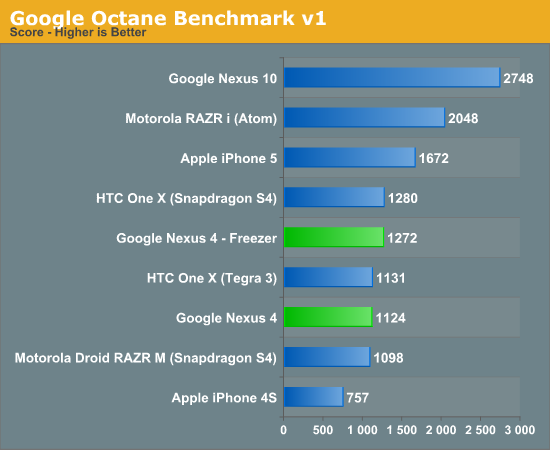
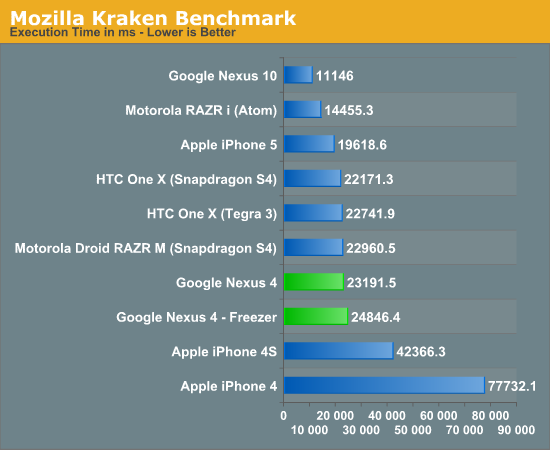
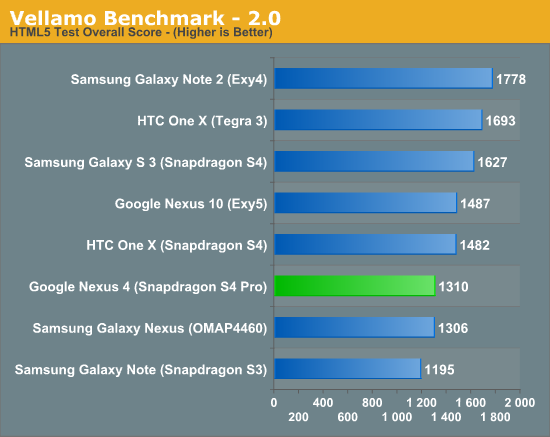
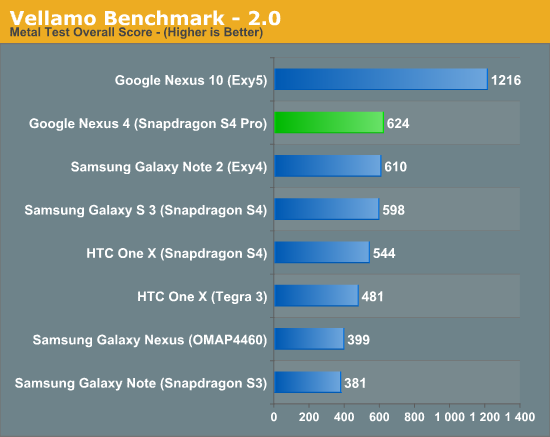
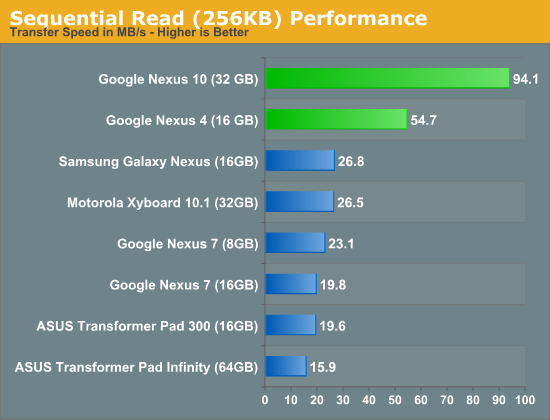
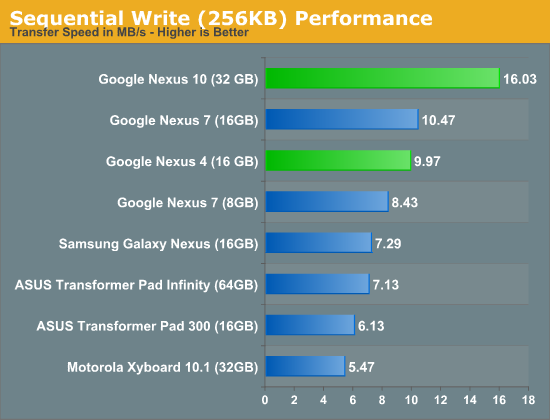
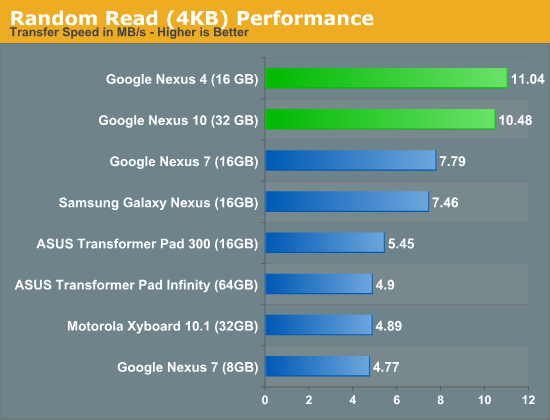
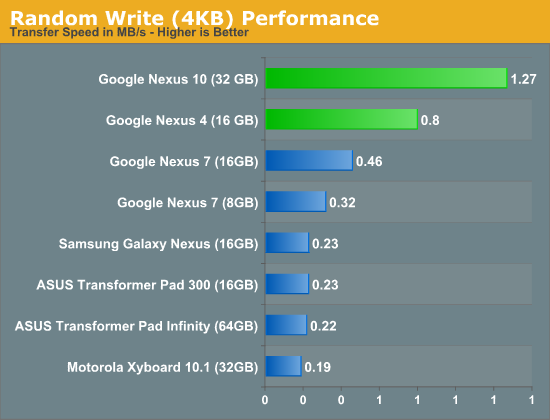
Our CPU performance side is unfortunately still dominated by JavaScript performance tests. The story there is that the Nexus 4 ships with Chrome (and originally shipped with a newer build of Chrome than what was on the market - we were running that updated version all along) and thus the mainline version of the V8 JavaScript engine. OEMs perform their own optimizations to the V8 library, and try to upstream whatever they can into the main project, but in the case of Chrome for Android that means V8 sans secret OEM sauce.










188 Comments
View All Comments
hulabaloo - Tuesday, November 13, 2012 - link
"We now have a form factor of device for every two inches of diagonal difference. "Should be three inches?
kyuu - Tuesday, November 13, 2012 - link
Thanks for the in-depth review, Mr. Klug. Greatly appreciated.Question: Is there a review for the Lumia 920 in the works? I'd really love to see a thorough review on it like this one from yourself or Anand.
aryonoco - Tuesday, November 13, 2012 - link
Thanks Brian, you've outdone yourself yet again. There is literally no reason to read any other Nexus 4 review.And also, a huge hats off to Anand for employing the very talented Brian and giving him a platform to show of his talents. You guys rock!
tuxRoller - Tuesday, November 13, 2012 - link
I suppose the end result explains how thry achieved the price of $300.About the SoC, is there anyway AT could do a more detailed review of the s4 pro? Perhaps something like what you did for Swift?
There is something seriously wrong with the s4 pro. Singke threaded performance shouod be really similar to the s4 but it is always as good bit slower. The memory performance has likewise regressed.
Has there been actual architectural changes made that causes this or is it something software releated (perhaps core affinity is nonexistent causing processes to keep moving between cores thus harming single thread performance).
Slaps - Tuesday, November 13, 2012 - link
""First, audioflinger is set to 48 kHz which results in software resampling causing artifacts for 41.1 kHz source material.""I think you mean 44.1 kHz not 41.1 kHz :)
Conficio - Tuesday, November 13, 2012 - link
Hi Brian,thanks for all the hard work that flowed into this review. Your drive to put out the best reviews is evident and you are succeeding when measured in the amount of data and information.
However, I'm considering this phone for my wife, and wanted to send it to her for a read. That is until I realized the enormous amount of comparisons to other phones, to other chips, etc. make it a really hard read. Somehow the text is a review and a history lesson mixed in one. I'd wished there would be a structure like the following:
* Introduction
* Form factor, feel, usability
* The phone's innards and benchmarks
* Comparison to phone X
* Comparison to phone Y
...
* The good, the bad, the ugly and conclusion
Funny that I'm as ambivalent about the phone. On the one side it looks great on price and basic features and independence of carriers and phone companies and their skin shenanigans (Why don't they compete on useful social or productivity software or at least make the skin removable). And I don't even need LTE, and can live w/o more memory. But then there is the thermal throttling going on and that just makes me uneasy. While it may not mean that much in today's real world applications, it is unnerving, that performance is something not reliable. It is there, but when you really use it it disappears. Reminds me of the unlimited ISP plans with speeds depending on your neighbor's usage and caps set so that they'll hurt in three years. I hope for really useful apps in three years to actually catch up to four cores.
What also bother's me is the camera. The low light performance is xoxo. But this horrible yellow tint is not something I'd appreciate. Can anybody recommend PC/ Mac OS X software to correct this? Can one set up something like a monitor calibration profile?
Conficio - Tuesday, November 13, 2012 - link
For a few years now we had the death grip test in every phone test. Has this problem disappeared altogether? How do we know? Due to tests or any other characteristic?staticx57 - Tuesday, November 13, 2012 - link
Not a problem with the review itself, but chrome is so far behind on Android that it absolutely kills the experience. If you compare AOSP browser vs chrome, not only does the AOSP browser faster in feel but kills chrome in benchmarks. It is pathetic that the Nexus 4 with krait scores 1800 ms sunspider but the Gnex on AOSP scores much better says something about the software Google chose to ship with.Impulses - Tuesday, November 13, 2012 - link
Google really needs to address this... Whether they need to start optimizing for the most popular SoC or simply update faster, it should not be that hard for them to improve on it.thesavvymage - Wednesday, November 14, 2012 - link
is there a way to just install the AOSP browser on the nexus? mine should be arriving friday if they ship on time and on my dad's gs3 i wasnt too impressed with chrome either